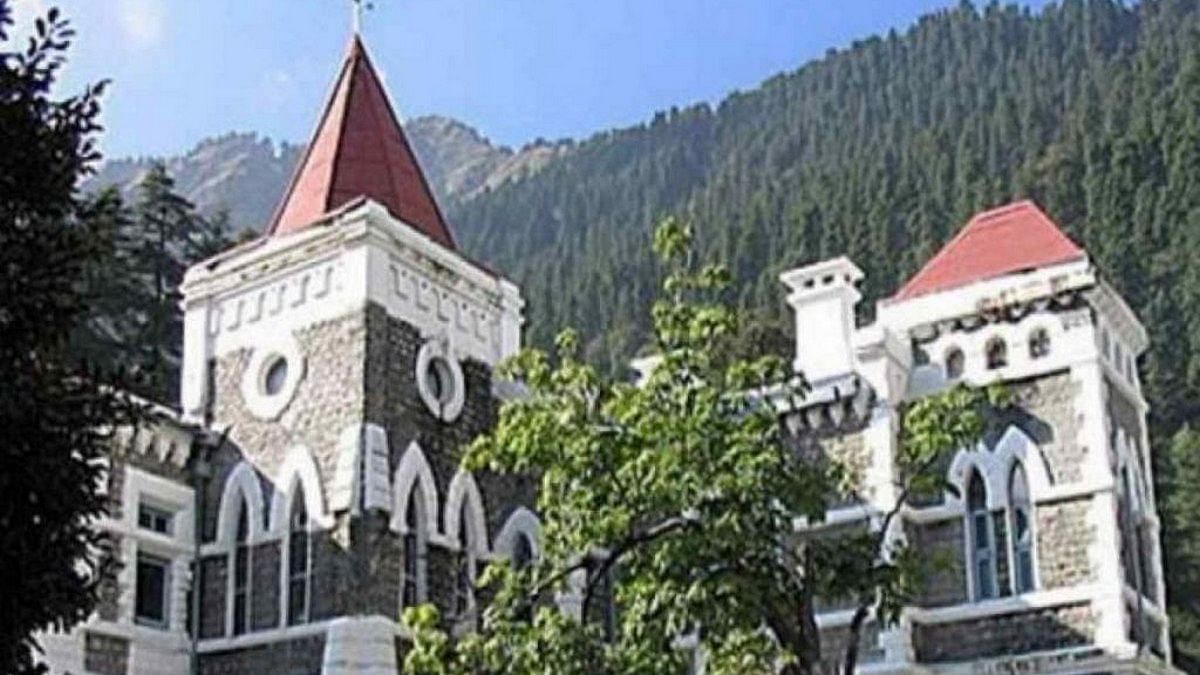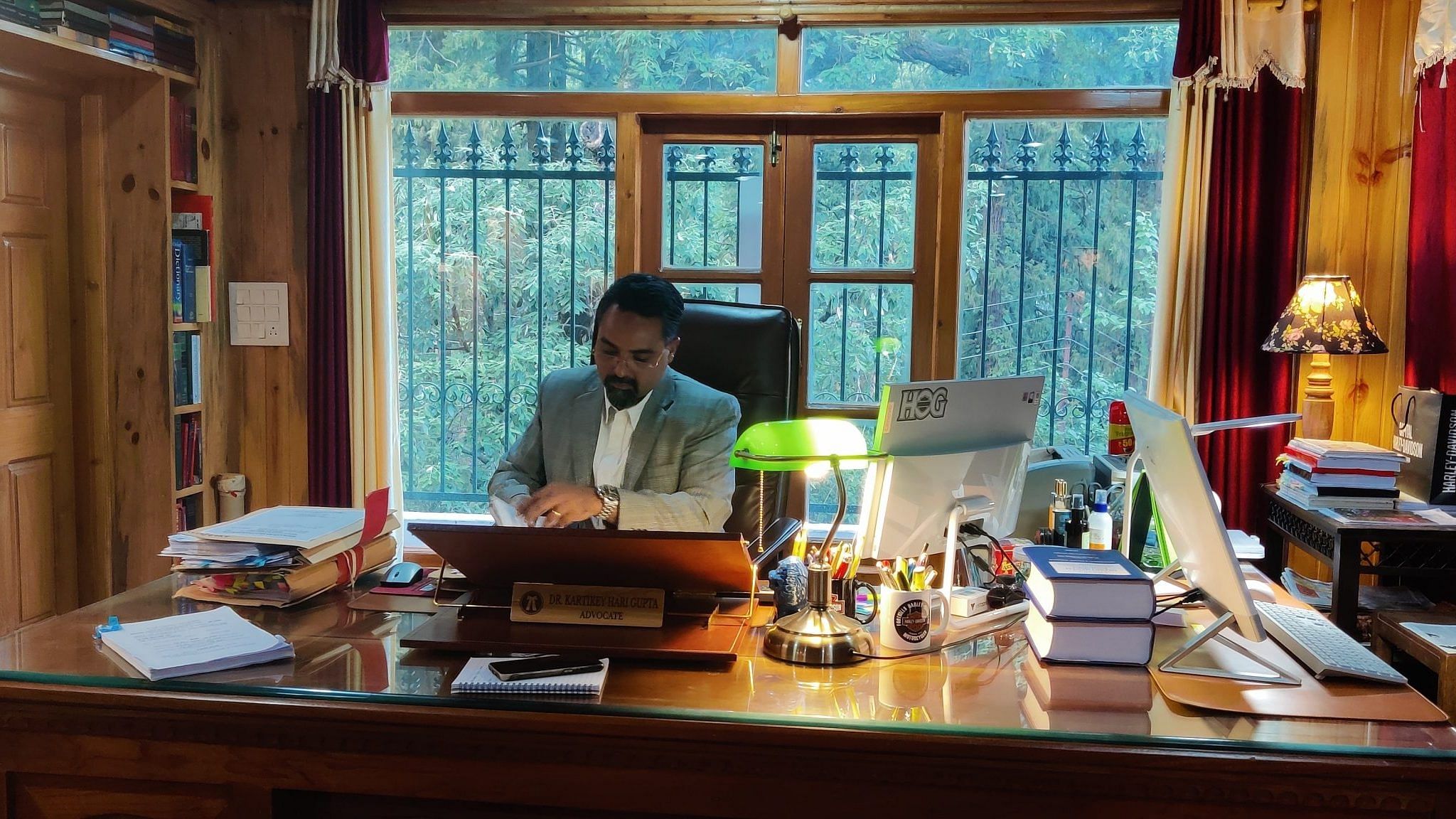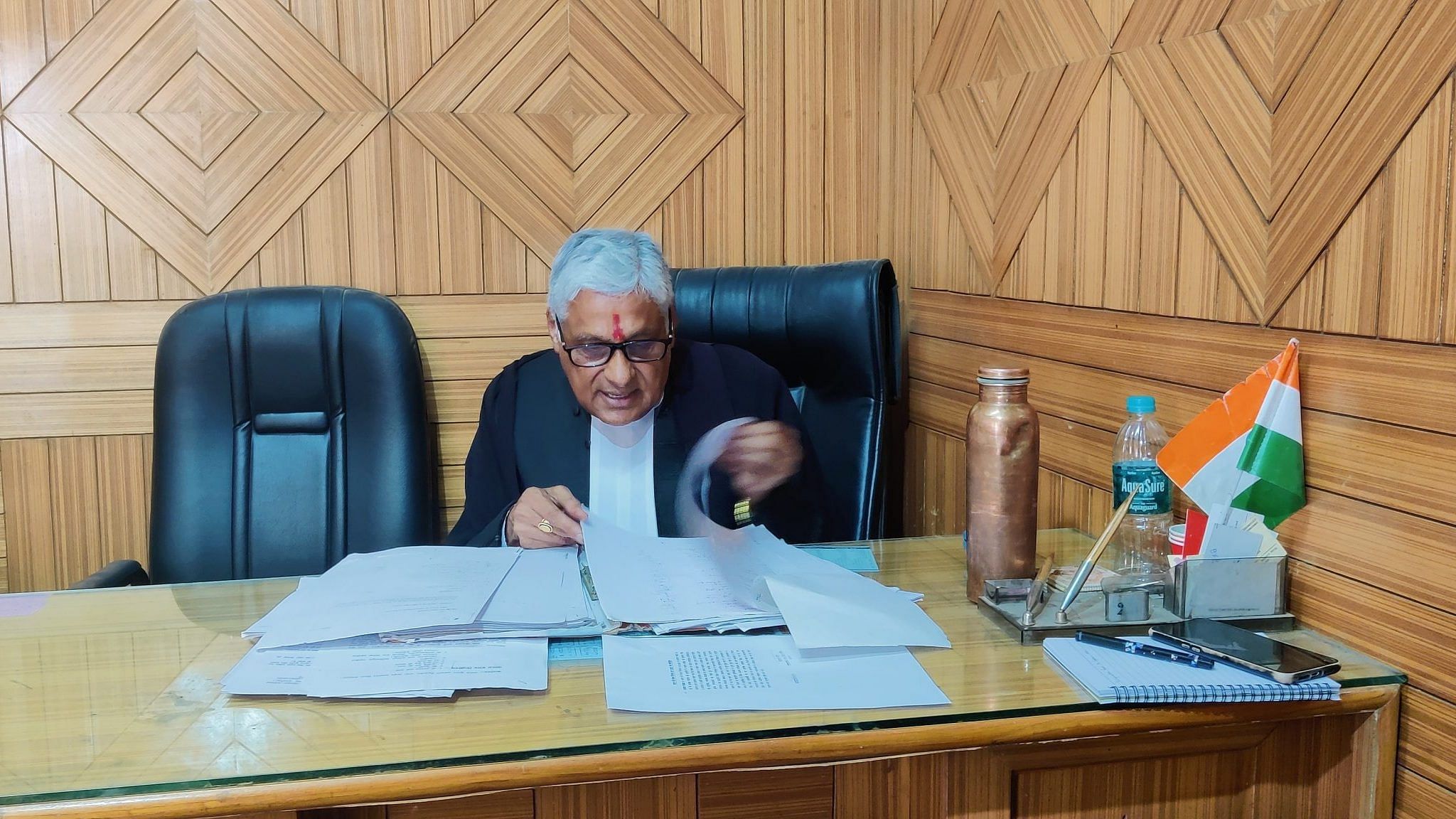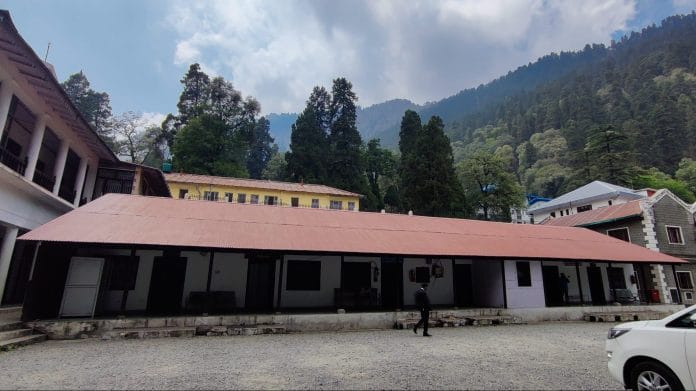Nainital: Armed police personnel in riot gear walked through a group of lawyers clad in black in the courtyards of the 19th-century gothic-style Uttarakhand High Court building on 8 May. Inside, judges debated shifting the high court out of Nainital. The debate was as unprecedented as the police presence.
That morning, the high court proposed moving a bench to Rishikesh, upsetting the lawyers who were asked to come back with a representation at 2 pm. Upon their return, they were greeted by the police presence. Everybody, including the chief justice, claimed ignorance about the police presence.
The proposal has since evolved from addressing practical difficulties in accessing the high court to reopening old regional divides in one of India’s youngest states. And that’s because the order uploaded on 10 May was allegedly starkly different from the one read out in the court two days before: it now spoke of shifting the entire high court, not just a bench.
Although the Supreme Court has stayed the order, it has revived insecurities that led to Uttarakhand’s formation in 2000 and reignited the Kumaon versus Garhwal and hills versus plains debate. Lawyers now anxiously discuss the future of the high court and the hill areas. Politicians haven’t been far behind either, with BJP leader Bhagat Singh Koshyari writing to Chief Minister Pushkar Singh Dhami about the issue.
“Just like it has been happening in Manipur, with the conflict between the Meiteis and Kukis…This is similar to that,” Bhuvnesh Joshi, senior executive member of the high court bar association in Nainital, told ThePrint. “If you want to shift everything to the plains, then why did you make a separate hill state?”

For the hills
When Uttarakhand was carved out of Uttar Pradesh in 2000, Dehradun became its temporary capital, while the picturesque Old Secretariat building in Nainital, built in 1900 opposite a garden of blooming flowers and the Naina Peak in its backdrop, became the high court.
Several buildings have come up nearby, forming a massive complex with winding roads, gravel pathways, deodar trees, and a view of the mountains.
The struggle for a separate state is still fresh in the minds of the people. A desire for political transformation and development tailored to the unique geographical and cultural setting of the hilly region undergirded the demand. Two decades since the state came into existence, many of these desires remain unfulfilled.
The bulldozers used in Dehradun in July last year actually laid the groundwork for the Uttarakhand High Court’s 8 May order.
“We felt that our hills were getting left behind in the country’s development. This led to people feeling that if they want to walk hand in hand with India’s development, they would need a smaller state that would be aware of the problems of the hills,” said advocate Syed Nadeem Moon (62), former Nainital bar association president and a member of the Uttarakhand Rajya Andolankari Manch.
Formed through the Uttar Pradesh Reorganisation Act 2000, Uttarakhand comprises two regions: Garhwal and Kumaon, which have historically been at odds with each other. Kumaon consists of six districts with Nainital as its headquarters, while Garhwal has seven districts with Pauri Garhwal as its headquarters.
Moon, who was part of the Uttarakhand movement, asserted that the aim behind the demand for statehood was the development of the hills.
“How will this development happen? It will happen when principal institutions like the capital or the high court or the directorates stay in the hills so that infrastructure develops,” he said.
Bulldozers started it all
The bulldozers used in Dehradun in July last year actually laid the groundwork for the Uttarakhand High Court’s 8 May order.
A demolition order targeted residential houses of ex-employees and VRS optees of the Indian Drugs and Pharmaceuticals (IDPL) in Rishikesh. Some houses were demolished, injuring a few senior citizens. The residents took the matter to the high court, asserting that the company still owed them pending dues.
An appeal filed by the state regarding the IDPL homeowners was scheduled for 21 May but was heard on 8 May instead. In an unprecedented move, the court asked the Chief Secretary of Uttarakhand to present a plan for shifting a bench of the high court to the IDPL premises in Rishikesh.
Advocate Kartikey Hari Gupta, representing the IDPL residents, was puzzled by the question of shifting. “I am still figuring out how this happened in our case, because our case was in regard to bulldozer action…In fact, my client asked me, ‘Sir, what is our concern with this?’,” he said, before explaining that the court felt a shifting exercise could be undertaken since a larger residential area was involved in this case.

On 8 May, news spread quickly, and bar association representatives, backed by scores of lawyers, swarmed the chief justice’s court, demanding to be heard. They were asked to submit a representation at 2 pm.
By 2 pm, the high court was swarming with armed policemen. The bench gave the Nainital bar association a week to return with suggestions on shifting, after discussing it among themselves.
Two days later, an order was uploaded on the high court website, omitting details of the 8 May events and containing two surprises—a referendum and a demand to find land for the entire high court to be shifted. It directed the Registrar General to open a portal by 14 May, which would stay open until 31 May.
‘A 42-year-old demand’
In Dehradun, posters appeared in the high court urging lawyers to visit the court website and vote ‘YES’ for the relocation. Local media covered how lawyers across Garhwal were uniting to advocate for a high court bench in their region. On the other hand, lawyers in Nainital were up in arms against the order and promptly approached the Supreme Court.
In one stroke, the high court order had polarised the state’s bar associations.
Advocate DCS Rawat, Nainital bar association president, emphasised the state’s historical “balance” sought during its formation.
“They believed that both the brothers (Kumaon and Garhwal) should be offered something to keep them at par with each other,” he said.
Rajbeer Singh Bisht, Dehradun bar association secretary, claims that their demand for a bench in Dehradun predates the state itself, originating 42 years ago under the Allahabad High Court.
Their petition also underscores the state’s historical context, arguing that the high court order unfairly neglected the rationale behind locating the state capital and judiciary in both regions, and “would upset” the social balance resulting in “adverse effect on the Kumaon region”.
Rajbeer Singh Bisht, Dehradun bar association secretary, claims that their demand for a bench in Dehradun predates the state itself, originating 42 years ago under the Allahabad High Court.
“We used to have a strike every Saturday until 2018, highlighting this demand,” he said.
Noting that 70 per cent of the state’s cases originate from Garhwal, he advocated for a bench in Haridwar, Rishikesh, or Roorkee because Nainital’s climate and terrain ‘aren’t suitable for everyone’. “This is why it has limited advocates, leading to a monopoly of a few lawyers there.”
‘It would become barren’
While the Nainital bar association prepared to take their fight to the Supreme Court, the Dehradun bar association focused on rallying support for the high court’s relocation referendum.
Conducting multiple meetings, they garnered support from MLAs across the Garhwal region, including Khajan Das (Rajpur Road), Brij Bhushan Gairola (Doiwala), Umesh Sharma Kau (Raipur), Savita Kapoor (Dehradun Cantonment), and Kishore Upadhyaya (Tehri), as per local media reports.
The issue gained political traction as senior leaders weighed in. Koshiyari, in his letter to Dhami, asserted that such decisions should be made by Parliament or the state legislature, not the high court. He emphasised the “established agreement” during Uttarakhand’s formation “that the High Court would be situated in Kumaon if the capital remained in Garhwal.”
This political involvement injected a regionalism dynamic, pitting Kumaon against Garhwal in discussions.
“We had demanded a bench of the high court in Dehradun…As far as the balance is concerned, our state has different parts and everybody’s opinion should be taken to take a decision with everybody’s suggestions,” Das, Rajpur Road MLA, said.
However, Sumit Hridayesh, MLA from Haldwani, viewed the situation as “unwanted”, expressing a desire for “balance”.
“Since the Garhwal region already holds the Vidhan Sabha and all the important offices, the people of the Kumaon region would feel that it would become barren if the high court is also shifted out,” he said.
The government did try to resolve the issue by offering an alternative site in Haldwani and had even identified 26 hectares of land in Gaulapar, but the high court rejected it.
The city offers better accessibility by road and rail compared to Nainital while still being located in Nainital district and in Kumaon region. In fact, several high court lawyers and members of the judges’ administrative staff live in Haldwani, travelling to Nainital every day for work. However, while it satisfied the Kumaon vs Garhwal debate, Haldwani’s location at the foothills of the Kumaon region meant it faltered on the hill vs plains debate and didn’t serve as the ideal location for the high court.
The court order also cited that 75 per cent of the proposed land in Haldwani is densely forested.
“The Court does not want to uproot any of the trees to make a new High Court. Keeping in view the above fact, we are not using that land,” the 8 May order said.
However, BJP leader from Almora, Vasudha Pant still advocates for Haldwani as the most suitable alternative due to its connectivity, if at all it needs to be shifted.
“You cannot centralise and concentrate everything at one place,” she said, referring to the most government institutions being in Dehradun.
Online hearings for whom?
Shiv Kumar, 32, regularly travels to Nainital for his younger brother’s bail hearing in a murder case. Every trip is a two-day-long affair and costs him around Rs 8,000-10,000. After a six-hour long drive from Haridwar, he usually reaches Nainital around 4 am, and then patiently waits for the high court gates to open around 10 am.
“If the (high court) shift does end up making a difference, then it’s a good thing,” he said, sipping his first tea of the day in the court canteen.
Due to the nature of proceedings, in the high court, the presence of litigants for cases isn’t absolutely necessary unless the court demands it. Several high court lawyers in Nainital ThePrint spoke to admitted litigants faced difficulty reaching the court, but pointed to digitisation efforts as having improved access to justice. Kumar, however, said he is yet to experience the benefits.
“We have never felt any convenience with the online hearings…Our lawyer doesn’t give us any updates. I have called her up thrice since the morning; she didn’t pick up even once,” he said.
Ravinder from Uttar Pradesh expressed a similar lack of trust in online hearings. The 31-year-old, who covers an eight-hour journey from Muzaffarnagar to track the bail application his two brothers’ bail plea in a narcotics case, says he has to be physically present in the court during the hearings. He knows how beneficial it would be if the high court was to move somewhere closer to his home.
“We wouldn’t have to keep roaming in the hills. Accidents can happen anywhere,” he said.
One high court, many claimants
This isn’t the first time that the difficult topography of Nainital has challenged the high court’s existence in the city.
In 2017 and again in 2019, high court lawyer MC Kandpal wrote letters to the high court, highlighting the “difficult topography” — pointing out issues with connectivity and space in the city.

The high court reacted swiftly in 2019, inviting suggestions from the public over the possible relocation of the high court. Responses poured in from various quarters, including professors and scientists, each proposing different locations across the state.
Everybody wanted the high court in their own backyards, singing praises of their neighbourhoods.
In 2020, another attempt was made by Roorkee-based lawyer Mamtesh Sharma, who filed a petition demanding a high court bench in the Garhwal Division, preferably in Dehradun or Haridwar. The court dismissed the petition, stating it couldn’t issue such an order. It also noted that Dehradun was designated as the state capital while the high court was established in Nainital “to cater to the aspirations of people from both these Divisions”.
Advocate Gupta, representing the bar association in the Supreme Court, highlights the legal challenges in shifting the high court.
“If at all this exercise is to be done, it is to be done by Parliament, because this notification [of establishing the high court at Nainital] has been issued under Section 26 (2) of the Reorganisation Act. That is a central legislation,” he told ThePrint. “The power was vested with the President of India to issue that notification. If anything has to be done again, the Parliament or the President will have to issue a notification.”
‘Be innovative, can’t keep shifting’
The concerns around shifting the high court echo those that inspired the state’s formation.
Many lawyers said that relocating the high court will “aggravate” Nainital’s geographical problems. These issues often lead to migrations from the hills, a long-standing concern for the state.
Uttarakhand Congress vice president Suryakant Dhasmana and local news reports note that the migration prevention commission has itself moved from Pauri Garhwal to Dehradun. The concentration of government departments in Dehradun has exacerbated concerns among those who see the high court as the last bastion of hope in the hills.
Advocate Gupta suggests innovation as a solution to these concerns.
“Running away from problems is not the solution…Such problems will come up at any other place too…You can’t keep shifting…It’s a lack of management and innovation. There is no space problem in the high court,” he said.
Hridayesh said that the high court’s placement in Nainital aids the region’s overall development.
This sentiment is prevalent among Nainital lawyers, who credit the high court’s presence for much of the city’s development over the years—whether it’s the removal of encroachment, or constant oversight over government contracts for development works, or addressing the parking space issues and street vendors’ rights.
One Nainital lawyer, speaking on the condition of anonymity, even credited the high court’s presence for the pristine condition of Naini Lake, despite the heavy influx of tourists.
“It’s because the judges like taking their morning walks around it,” he explained with a smile.
(Edited by Prashant)






